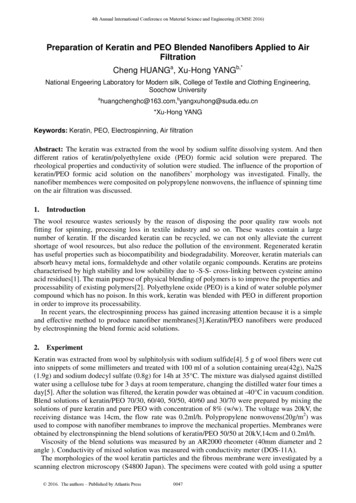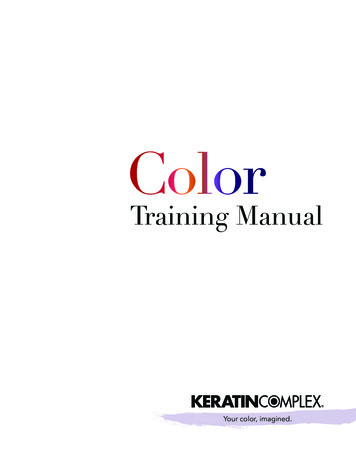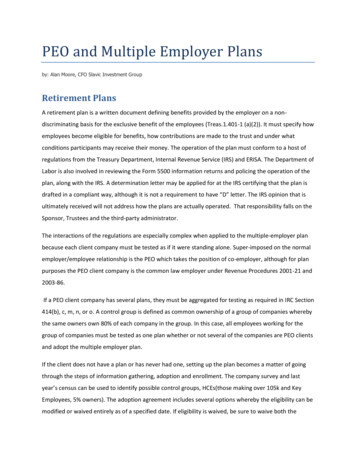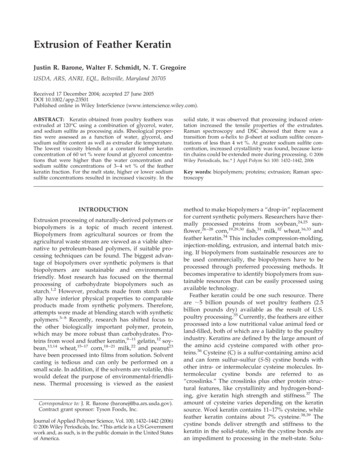
Transcription
4th Annual International Conference on Material Science and Engineering (ICMSE 2016)Preparation of Keratin and PEO Blended Nanofibers Applied to AirFiltrationCheng HUANGa, Xu-Hong YANGb,*National Engeering Laboratory for Modern silk, College of Textile and Clothing Engineering,Soochow du.cn*Xu-Hong YANGKeywords: Keratin, PEO, Electrospinning, Air filtrationAbstract: The keratin was extracted from the wool by sodium sulfite dissolving system. And thendifferent ratios of keratin/polyethylene oxide (PEO) formic acid solution were prepared. Therheological properties and conductivity of solution were studied. The influence of the proportion ofkeratin/PEO formic acid solution on the nanofibers’ morphology was investigated. Finally, thenanofiber membences were composited on polypropylene nonwovens, the influence of spinning timeon the air filtration was discussed.1.IntroductionThe wool resource wastes seriously by the reason of disposing the poor quality raw wools notfitting for spinning, processing loss in textile industry and so on. These wastes contain a largenumber of keratin. If the discarded keratin can be recycled, we can not only alleviate the currentshortage of wool resources, but also reduce the pollution of the environment. Regenerated keratinhas useful properties such as biocompatibility and biodegradability. Moreover, keratin materials canabsorb heavy metal ions, formaldehyde and other volatile organic compounds. Keratins are proteinscharacterised by high stability and low solubility due to -S-S- cross-linking between cysteine aminoacid residues[1]. The main purpose of physical blending of polymers is to improve the properties andprocessability of existing polymers[2]. Polyethylene oxide (PEO) is a kind of water soluble polymercompound which has no poison. In this work, keratin was blended with PEO in different proportionin order to improve its processability.In recent years, the electrospinning process has gained increasing attention because it is a simpleand effective method to produce nanofiber membranes[3].Keratin/PEO nanofibers were producedby electrospinning the blend formic acid solutions.2.ExperimentKeratin was extracted from wool by sulphitolysis with sodium sulfide[4]. 5 g of wool fibers were cutinto snippets of some millimeters and treated with 100 ml of a solution containing urea(42g), Na2S(1.9g) and sodium dodecyl sulfate (0.8g) for 14h at 35 C. The mixture was dialysed against distilledwater using a cellulose tube for 3 days at room temperature, changing the distilled water four times aday[5]. After the solution was filtered, the keratin powder was obtained at -40 C in vacuum condition.Blend solutions of keratin/PEO 70/30, 60/40, 50/50, 40/60 and 30/70 were prepared by mixing thesolutions of pure keratin and pure PEO with concentration of 8% (w/w). The voltage was 20kV, thereceiving distance was 14cm, the flow rate was 0.2ml/h. Polypropylene nonwovens(20g/m2) wasused to compose with nanofiber membranes to improve the mechanical properties. Membranes wereobtained by electronspinning the blend solutions of keratin/PEO 50/50 at 20kV,14cm and 0.2ml/h.Viscosity of the blend solutions was measured by an AR2000 rheometer (40mm diameter and 2angle ). Conductivity of mixed solution was measured with conductivity meter (DOS-11A).The morphologies of the wool keratin particles and the fibrous membrane were investigated by ascanning electron microscopy (S4800 Japan). The specimens were coated with gold using a sputter 2016. The authors – Published by Atlantis Press0047
4th Annual International Conference on Material Science and Engineering (ICMSE 2016)coater and their morphology was observed under the SEM at an acceleration voltage of 5 kV[6].Air filtration performance of composite membrane was tested by 8130 type automatic filter tester,and we used sodium chloride aerosol whose median grain size was 75nm as a particulate filter andtest air flow rate was 85L/min .Then S4800 scanning electron microscope (SEM) was used to observechanges of the morphology.3.Results and Discussion3.1 Rheology and ConductivityThe rheological properties of the keratin/PEO formic acid solutions are shown in Fig.1a. Due to theloose molecular chain, the viscosity of keratin fomaid acid solution is very low. However, the relativemolecular weight of PEO is 400000, there are more nodes between the molecules, so the viscosity ofPEO fomaid acid solution is much higher. With the increase of shear rate, the shear viscositydecreases gradually.As we can see in Fig.1b, pure keratin solution has higher conductivity because of polar aminoacids[7]. With the increase of keratin, the viscosity of the solutions decreases gradually while theconductivity increases.Fig.1 (a) Rheology of solutions, (b) Viscosity and conductivity of solutions3.2 MorphologySEM images of nanofiber prepared by different proportion solution are shown in Fig.2. Thenanofibers are smooth and uniform, and there is no adhesion between nanofibers. The change of theproportion of keratin and PEO mainly resulted in changes of viscosity and conductivity of themixed solutions. In the appropriate range, the decrease of viscosity and the increase of conductivityis conducive to the drawing of nanofibers. As summarized in Table 1, with the increase of keratin,the diameter of nanofibers decreases obviously. 2016. The authors – Published by Atlantis Press0048
4th Annual International Conference on Material Science and Engineering (ICMSE 2016)Fig.2 (a)Keratin/PEO 30/70 (b) Keratin/PEO 40/60 (c) Keratin/PEO 50/50(d) Keratin/PEO 60/40 (e) Keratin/PEO 70/30Table 1: Average diameter of different raito solutionsKeratin/PEOAverage diameter 14.83.3 Air FiltrationThe air filtration of the samples with different spinning time are shown in Fig.3. As shown in Fig.3a,the penetration of polypropylene nonwoven fabric is near 100 per cent. That means nonwovenfabric has very poor air filtration performance .When the spinning time was 1h, the transmissionrate of the composite membrane decreased obviously. This is due to high specific surface area andstrong adsorption capacity of nanofibers. With the increase of spinning time, the fiber layer becamethicker, the gap between fibers became smaller. As a result, the penetration rate decreased, and theresistance increased gradually, air filtration performance became batter. The recommend finalpressure drop of fine filter is 450Pa. When the spinning time was 4h, the resistance was 352.7Pa,and the penetration was about 93.9%, so the air filtration performance was quite well. 2016. The authors – Published by Atlantis Press0049
4th Annual International Conference on Material Science and Engineering (ICMSE tance (Pa)30010020500001234spinning time(h)Fig.3 (a) Penetration and resistance, (b) SEM image of composite membraneFig.3b shows morphology of the composite membrane after filtration. Filtering mechanism ismainly divided into diffusion effect, interception effect, momentum effect, sieve effect, electrostaticeffect etc. It can be seen that diameter of aerosol is much smaller than that of the nanofibers, so thesieve effect is very little, while diffusion effect, interception effect and momentum effect play animportant role in filtration.SummaryIn this work, wool-derived keratin nanofiber membranes were prepared by the electrospinningkeratin/PEO blended formic acid solutions. With the increase of keratin, the viscosity of thesolutions and the diameter of nanofibers decreased gradually, while the conductivity increased.Compared to the single polypropylene nonwovens the air filtration performance of the compositmaterials of polypropylene nonwoven/nanofibers were obviously improved. And with theincreasing spinning time the penetration rate of nano particulate decreased indicating that the airfiltering effect became better. However, the filtration resistance increased gradually. When thespinning time was 4h, the composite membranes had the best air filtration performance.The diameter is play an important role in air filtration, there are many other factors that affect thediameter of the nanofibers, such as mass fraction, voltage, rate of flow, spinning distance etc.Therefore, the future research may focus on the effect of spinning parameters on air filtrationperformance.References[1] Zoccola M, Aluigi A, Tonin C. Characterisation of keratin biomass from butchery and woolindustry wastes[J]. Journal of Molecular Structure, 2009, 938(1):35-40.[2] Kausar A, Zulfiqar S, Sarwar M I. Nanoblends of PMMA/aramid: A study on morphological andphysical properties[J]. Solid State Sciences, 2013, 24(10):36-43.[3] Aluigi A, Corbellini A, Rombaldoni F, et al. Morphological and structural investigation ofwool-derived keratin nanofibres crosslinked by thermal treatment[J]. International Journal ofBiological Macromolecules, 2013, 57(6):30-37.[4] Candela MP, Martinez JM, Macia RT. Chromium(VI) removal with activated carbons[J]. WaterResearch, 1995, 29(9):2174–2180.[5] Aluigi A, Tonetti C, Vineis C, et al. Adsorption of copper (II) ions by keratin/PA6 blend 2016. The authors – Published by Atlantis Press0050
4th Annual International Conference on Material Science and Engineering (ICMSE 2016)nanofibres[J]. European Polymer Journal, 2011, 47(9): 1756-1764.[6] Li J, Li Y, Li L, et al. Preparation and biodegradation of electrospun PLLA/keratin nonwovenfibrous membrane[J]. Polymer Degradation & Stability, 2009, 94(10):1800-1807.[7] Aluigi A, Vineis C, Varesano A, et al. Structure and properties of keratin/PEO blendnanofibres[J]. European Polymer Journal, 2008, 44(8): 2465-2475. 2016. The authors – Published by Atlantis Press0051
Viscosity of the blend solutions was measured by an AR2000 rheometer (40mm diameter and 2 angle ). Conductivity of mixed solution was measured with conductivity meter (DOS-11A). The morphologies of the wool keratin particles and the fibrous membrane were investigated by a scanning electron microscopy (S4800 Japan).










